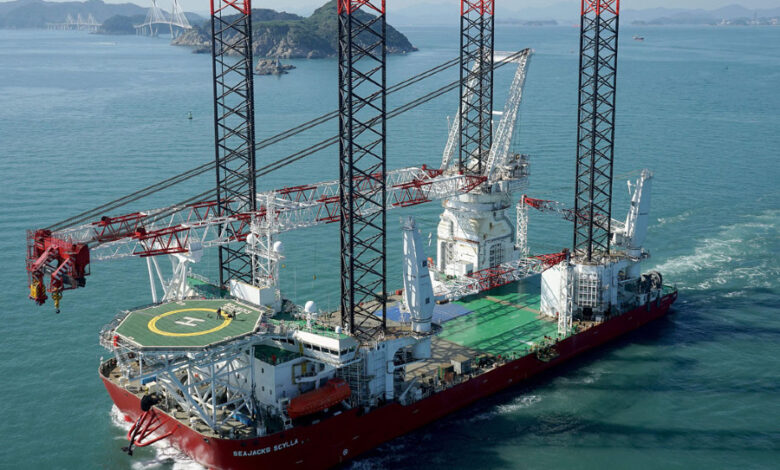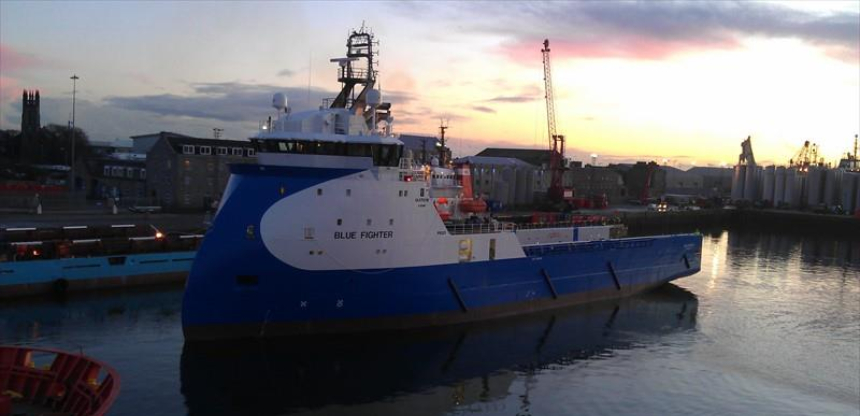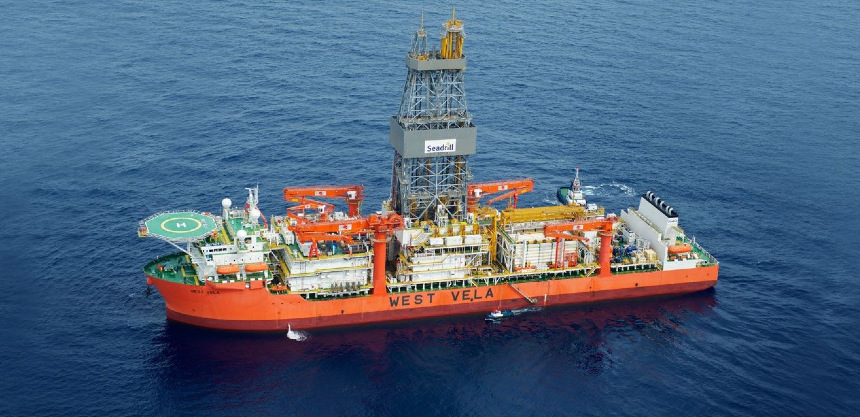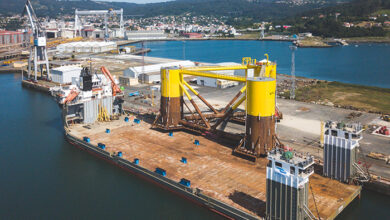HomeNewsOffshore News
Offshore : The deals are on! – Rigs, boats, and jackups start to change hands

Summer is usually a quiet time for deals, when investment bankers retreat to their villas in the south of France, Norwegian shipowners retire to their family chalets for fishing and sailing, and billionaires blast off to space.
The last few weeks have blown that perception right out the water, with a series of mega-deals that will transform several sectors of the industry, and may provide a roadmap for future offshore opportunities.
Here’s our guide to what’s hot in this sizzling summer of 2021.
Eneti buys Seajacks
A year ago, in 2020, Scorpio Bulkers made a serious strategic change of direction when its owner and CEO Emanuele Lauro decided to ditch the company’s fleet of bulk carriers and become a pure-play wind farm turbine installation vessel (WTIV) owner, the only one listed in the USA.
Mr. Lauro spotted the opportunity of a lifetime – double-digit compound growth is forecast in the offshore wind sector for the next decade (here), and for several decades beyond. We reported on the signature of the letter of intent with Daewoo Shipbuilding and Marine Engineering (DSME) in Korea for one firm GustoMSC designed jackup WTIV and three optional units here. Eneti then firmed up the new building contract and began selling off its legacy fleet of bulk carriers, just as the dry market surged (here).
Last week, Eneti announced it would buy rival Seajacks, for a mix of cash and Eneti shares, in the biggest windfarm installation consolidation ever. Seajacks’ fleet of five WTIVs was valued at US$600 million, Eneti said in its insightful presentation on the deal.
Eneti is paying the current owners of Seajacks, Japanese players Marubeni Corporation, INCJ, and Mitsui OSK Lines (MOL), just over eight million Eneti shares, US$74 million in newly-issued redeemable notes, and around US$12 million in cash. Eneti also takes on US$299 million in assumed net debt from Seajacks through the transaction. When the deal closes, Marubeni Corporation, INCJ, and MOL will end up holding 42 percent of pro forma Eneti shares.
Win-win?
For once this looks like a deal that could be a win/win for both parties. Eneti was excited to explain that Seajacks has a contracted revenue of US$200 million this year, and US$118 million for next year, with an estimated 2021 EBITDA of US$125 million. There was no mention of any net income or profit, however, confirming our suspicion that, like Cadeler, the company has struggled for profitability in recent years, despite surging demand.
Seajacks had a strategic problem. Of its fleet of five WTIVs, three are smaller and older jacks-ups of the NG2500X design, built at Lamprell in the UAE with only 300-tonne or 400-tonne cranes, which are too small for installing modern turbines, so this trio performs maintenance work only.
Seajacks Scylla and Seajacks Zaratan are much more modern and capable assets, with 1,540-tonne and 800-tonne cranes, respectively. Seajacks Scylla is currently working in Taiwan for Ørsted, installing 111 turbines, each of eight MW capacity, through to next year. Seajacks Zaratan has been assigned to installations in Japan and has further work in the North Asian region after that, Eneti reported.
But one premium WTIV was not enough for Seajacks to compete at scale against the Big Five integrated contractors, nor against Cadeler or Fred Olsen Windcarrier. Consolidation with Eneti provides access to a second high-end unit and access to further equity through Eneti’s New York listing.
Eneti buys experience
Even after the decision to invest in a shiny new jackup in 2020, Eneti faced an age-old challenge for new entrants into the offshore industry: credibility. How could the company win the trust of clients that it would be capable of executing complex and operationally critical work safely? With Eneti having no track record, many operators would be sceptical of the company’s capabilities.
The sinking of the Chinese jackup WTIV Sheng Ping 001 off Guangdong province with the loss of four lives, which we covered here, demonstrates the serious consequences of operational problems when things go wrong in wind farm installations. The capsizing of Sheng Ping 001 follows the punch-through that led to the loss of the Malaysian jack up Naga-7 in May off Bintulu, and the sinking of the jackup lift boat Seacor Power off Louisiana in a squall in April (here). Jackup safety is suddenly in the spotlight as never before.
Buying Seajacks neatly solves Eneti’s experience problem at a stroke: Eneti can now demonstrate that its units, the former Seajacks fleet, have already installed 470 wind turbine generators and 450 foundation structures. The new building in Korea can be managed by the Seajacks team when it delivers, and Eneti has access to Seajack’s experienced crew.
Win-win.
Esvagt wins big and long, with battery power
Last week we looked at the contrasting fortunes of private equity-owned businesses in the offshore sector (here). We highlighted that under the ownership of private houses 3i and AMP Capital, Denmark’s safety standby operator Esvagt had gone from strength to strength, outshining its former sister company Maersk Supply Services.
Further evidence of Esvagt’s rise emerged last week when the company announced a whopping eight-vessel deal with TotalEnergies in the Danish sector (here). Total has ditched its previous model of supply vessels performing supply work to the company’s installations, whilst dedicated emergency response and rescue vessels (ERRVs) perform standby work.
Instead, under a “re-thinking of the operational structure,” Esvagt will buy two of the former NAO, former Hermitage Offshore PX121 design PSVs. The duo will be upgraded to ERRV class and fitted with bigger fast rescue craft, so that they can combine both supply work and standby duties on long-term charter to TotalEnergies.
Fighter and Prosper join the expanded fleet
 NAO Fighter, later renamed Hermit Fighter (Photo: MarineTraffic.com/Maksimiljan Ostaric)
NAO Fighter, later renamed Hermit Fighter (Photo: MarineTraffic.com/Maksimiljan Ostaric)
As a result, Esvagt will acquire the DP2 Hermit Fighter and Hermit Prosper from Pearl Bido, the Scandinavian bank-controlled entity that owns them (here). The PSVs will undergo conversion to standby class at their original build yard, Ulstein Verft in Norway, starting in October. The ships will also be fitted with battery systems for hybrid operations, another move in the “green transformation,” which we highlighted here. The conversion to hybrid propulsion will be conducted by Ulstein Power and Control.
Also joining the armada of Esvagt vessels chartered by TotalEnergies is Esvagt Dana, a combined “walk to work” and ERRV, again emphasising the move in TotalEnergies towards flexible, multi-purpose units. Five standard Esvagt ERRV units will also be chartered as well, for varying lengths, including on the Tyra project.
Tyra is Denmark’s Next Top Energy Model
TotalEnergies operates the Tyra platform in Danish waters. The platform has been a major part of the North Sea’s energy infrastructure for nearly 40 years (here). More than 90 percent of Denmark’s natural gas is processed and sent to shore via the Tyra facilities.
As well as bringing in hybrid vessels, Tyra’s transformation will also have a significant impact on its energy efficiency: CO2 emissions will be reduced by 30 percent and flaring can be reduced by 90 percent. This is the future of the North Sea production model: lower carbon emissions from both the facilities and the support vessels.
The “for sale” price tag just got bigger
The deal looks certain to make Esvagt more attractive as an acquisition target when its private equity owners look to cash out and exit, as the company’s CEO has hinted. Long-term contracts with hybrid vessels on a lower carbon development in Danish waters tick all the environmental, social, and governance boxes for Esvagt’s existing owners, and for any future shareholders and lenders.
Another win-win deal.
Les Abeilles buys big as well
Another private equity-owned company that has bought big is French towage specialist Les Abeilles. As part of the disintegration of Bourbon after its bankruptcy (here), Les Abeilles was sold to the French private equity group Econocom in late 2020 (here).
Now Les Abeilles has demonstrated that its private equity owners are capable of expanding the business and of investing for the future. In June, Les Abeilles announced it was buying the two large anchor handers Siem Garnet and Siem Diamond from debt-laden Norwegian owner Siem Offshore, which has been involved in a tense restructuring with its lenders (here).
The AHTS are VS491 CD design vessels with close to 300 tonnes bollard pull and Brattvaag 500-tonne line pull winches, built at Kleven Verft in Norway in 2010. The DP2 ships provide a significant upgrade to modernize France’s emergency response fleet, and the sale provides relief to Siem’s creditors. Siem still has a fleet of eight sister VS491 sister vessels (here).
Full circle for Les Abeilles
In many ways, the transaction illustrates the folly of Bourbon’s rise and fall, as it sold quality assets in Europe with long-term cashflows to buy speculative offshore vessels in China, which have mostly ended up laid up and sold for cents on the dollars.
Les Abeilles was one of Jacques de Chateauvieux’s first forays into creating a French maritime giant, when Bourbon purchased French tug giant Les Abeilles International in 1996. Les Abeilles then operated some 75 port and deep-sea tugs, as per the company’s history here. In order to fund the explosive growth of Bourbon’s offshore fleet in 2003,
Bourbon sold the tug fleets operating in the ports of Calais, Boulogne, Cherbourg, Bayonne, Sète, and Nouméa (New Caledonia) to Compagnie Maritime Chambon, created in 2002 by Guy Chambon – who was a descendant of the founder of the original Chambon group, which had been taken over by Bourbon in 1991.
Talk about the circle of life.
Bourbon gave Boluda a boost
Then in December 2007, Bourbon sold the remaining harbour towage fleet, consisting of seventy tugs, and one thousand employees to Spain’s Grupo Boluda for €270 million (now US$325 million). The deal increased Boluda’s workforce and turnover by 30 percent and catapulted the company into the front ranks of global towage operators.
Bourbon announced that as part of its “Horizon 2010” strategy (here) it would use the proceeds of the sale of Boluda to build ten Guido Perla GPA696 design subsea vessels in China at a total price of €450 million (now US$540 million), in addition to the one hundred other OSVs it had already committed to constructing at the time.
Bourbon kept only the Les Abeilles International division, which was a member of the International Salvage Union, and which operated three deep-sea emergency towing vessels commissioned in 1976 by the French Navy for coastal protection – Abeille Flandre (based in Toulon), Abeille Languedoc (from La Rochelle–La Pallice) and Carangue (Toulon) were retained.
Bourbon had also invested in two 200-tonne bollard pull units as well, which the company built at Myklebust shipyard in Norway in 2005. These were Abeille Bourbon (which operated out of Brest) and the Abeille Liberté out of Cherbourg.
France follows Norway
Siem Garnet and Siem Diamond provide much-needed modern tonnage to the Les Abeilles fleet after more than a decade of neglect under Bourbon’s ownership. With ever-larger container vessels plying coastal waters, the need for higher-capacity emergency response vessels is vital. Norway had already taken the lead by chartering two high horsepower Boa AHTS (Boa Bison and Boa Jarl) for emergency response duties in 2019 (here). France is to be commended for the following suit.
Private equity comes to drilling
In our piece on private equity, we blithely noted that private equity, with its preference for businesses with more stable, long-term cash flows that are more amenable to debt increases and financial engineering, had largely stayed away from offshore drilling industry.
Dolphin rises from Olsen’s ashes
We had, of course, forgotten about the acquisition of Dolphin Drilling by American private equity house SVP Global, which acquired the rump of bankrupt Fred Olsen Drilling in 2019.
Dolphin owns a fleet of three fifth- and sixth-generation Enhanced Aker H3 semisub drilling rigs (here): Bideford, Borgland, and Blackford Dolphin. It was rumoured as one of the participants in an opportunistic offer to dismember Seadrill when that company emerged from Chapter Eleven bankruptcy protection in July. ]
Reuters reported here that Dolphin, Transocean, and a third partner had sought to cherry-pick some of Seadrill’s best on-contract rigs from the company, in competition with a rival bid from Noble Corporation.
Dolphin doesn’t get Seadrill yet
Instead, on July 24, Seadrill announced that it had reached an agreement with its debtors for a plan of reorganization that will raise US$350 million in new financing and reduce the company’s liabilities by over US$4.9 billion, as debt is swapped for equity (here).
So far, its new owners have not yet announced any asset sales. Dolphin must wait.
Japan Drilling Company is the next private equity venture
Like nearly every other driller worldwide, Japan Drilling Company (JDC) was hard-hit by the collapse in offshore activities in 2015 and the continuing market downturn. In 2018, the company filed a petition with the Tokyo District Court for the commencement of corporate reorganisation proceedings under the Corporate Reorganisation Act of Japan.
JDC was bust, despite selling rigs and reducing its overheads. Reduced to a rump of four jackups and one mid-water semisub, plus the management of the Japanese deepwater research drillship Chikyu, JDC lacks the scale of its international competitors. However, in June, JDC announced that its jackup Hakuryu-10 had won a three-year firm plus two-year option contract commencing in the second quarter of 2022 in direct continuation of its current charter on the Al-Shaheen field in Qatar with North Oil.
Aspirant has aspirations offshore
We have already identified how private equity loves long contracts and predictable cashflows. So, JDC joined Dolphin in the private equity stable in early August when it announced that Japanese private equity house The Aspirant Group would take the company out of bankruptcy and inject capital into JDC, keeping its existing management.
“With a capital injection from funds related to Aspirant Group, JDC will begin a new chapter in its history,” the company said in a statement to the industry press.
That’s better than liquidation, at least.
Seadrill Partners becomes Aquadrill
 West Vela (Photo: Seadrill Partners)
West Vela (Photo: Seadrill Partners)
Ahead of Seadrill leaving bankruptcy, its former affiliate Seadrill Partners had also restructured with yet another debt for equity swap, wiping out US$2.9 billion of loans to emerge debt-free. Seadrill no longer retained any shares in the business and its new owners (the former creditors) took a different tack. Firstly, they renamed the company as Aquadrill. Then, they dropped the Seadrill prefix “West” from the names of all the drilling units.
Rather than retain Seadrill’s management, the new owners decided to split the Aquadrill rigs amongst a variety of managers. The fleet consists of four ultra-deepwater drillships, four ultra-deepwater semi-submersibles, and three tender assist drilling units. Marketing and operations for the fleet were handed over to Diamond Offshore Drilling, Energy Drilling, Odfjell Drilling, and Vantage Drilling.
Unfortunately, only two rigs in the fleet are currently working according to the fleet status report (drillships Vela and Capella), and these remain under Seadrill’s operational management until they complete their contracts.
This partition between different drilling contractors clearly sets up Aquadrill either for the sale of the rigs one by one to the managers if they win work for the ships, or to private equity or other financial interests if the company is able to get some long-term contracts.
Seadrill Partners is dead. Long live Aquadrill!
If this many deals can happen over the usually quiet summer months, just think what autumn will bring. Low-interest rates, the offshore wind frenzy, and the renewed confidence of the oil and gas sector with oil currently trading above US$70 per barrel are key factors to provide a bumper deal season in offshore for the rest of the year.
Reference: BAIRD













